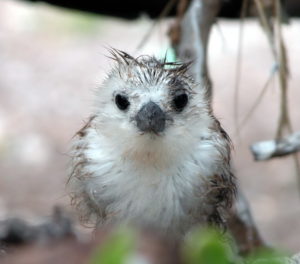
A White Tern chick after a rainstorm. ©Susan Scott
January 11, 2022
Our Kolea may have loved the recent Kona storm (see https://bit.ly/33e52DM) but Honolulu’s Manu-o-Ku did not. The wind and rain blasted their branches and doused their chicks. Even so, according to volunteers who monitor the city’s White Tern’s, Manu-o-Ku parents lost surprisingly few youngsters and eggs.
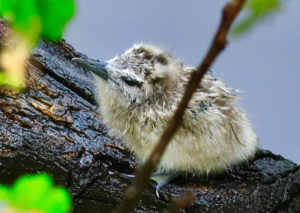
A Honolulu chick with outer feathers wet, inner down feathers still dry. An adult tern’s outer feathers are waterproof, but their chick’s are not. If a chick gets soaked to the skin, it can get too cold to survive. © Photo courtesy Clyde Kamishita
It’s sad for us Manu-o-Ku admirers to see our White Terns get pasted by storms, and even sadder to see them get eaten by predators. When the predators are invasive species people brought to Hawaii, such as rats, cats, and mongooses, it’s heartbreaking. When the predators are native species, however, it’s still sad but easier to accept. Predators are an integral part of healthy ecosystems, and drivers in natural selection.
One native species that occasionally preys on Honolulu’s White Terns is the ‘Auku’u, or Black-Crowned Night Heron, a native species that was revered as ‘aumakua, or guardian spirit, by ancient Hawaiians.
The species is a Hawaii native, and also a world traveler. This hardy heron has made its way, on its own, to every continent except Antarctica and Australia, making it the most widespread heron in the world.
‘Auku’u’s main diet is fish and other aquatic animals in either fresh or salt water. The numerous nonnative tilapia that crowd our steams and canals are easy pickings for these herons.
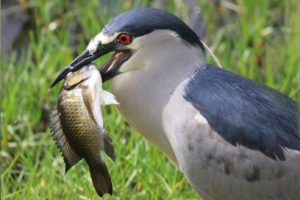
A black-crowned Night Heron with its favorite meal of tilapia. © Photo courtesy Tom Fake
In natural wetland areas, Black-Crowned Night Herons sometimes eat native waterbird eggs and chicks. And occasionally, a hungry heron will nab a White Tern.
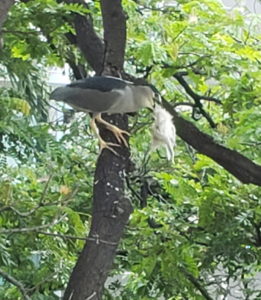
On January 7, 2022, this Black-Crown Night Heron caught a White Tern in a tree near the Target store of Ala Moana. On January 10, 2022, the observer, Marguerite Daysog, saw a pair of White Terns courting on the same branch. © Photo courtesy Marguerite Daysog
Another native Manu-o-Ku predator is the Peregrine Falcon. Like the ‘Auku’u, this remarkable bird has also made it, under its own power, around the world, from the Arctic tundra to the tropics, in wetlands and throughout deserts. A Peregrine Falcon or two occasionally make it to Hawaii. Since 1980, 1-to-3 individuals have been reported here annually. I’ve seen one several times at Midway Atoll, and one currently resides in Honolulu.
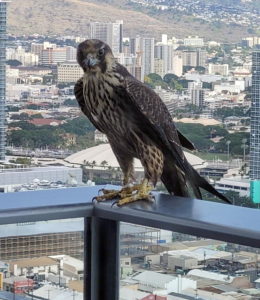
Honolulu’s resident Peregrine Falcon in Kaka’ako, November 24, 2021. Peregrine Falcons like to perch in high places, swooping down on prey below. © Photo courtesy Karen Chun
In November, 2020, environmental scientist, Michael Walther, published his observations and photos of a Peregrine Falcon in Honolulu in the ‘Elepaio, bit.ly/3r4LUjm, the journal of the Hawaii Audubon Society.
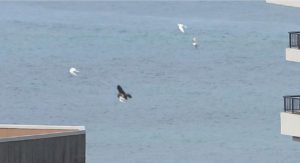
Michael Walther’s photo of a Peregrine Falcon catching a White Tern in flight above the Hilton Hawaiian Village on November 30, 2020. This may be the same falcon that’s still in Honolulu. Photo from ‘Elepaio, Vol 81, #4 (link above.)
Peregrine Falcons eat anything they can catch, mostly taking bats and birds in the air in spectacular dives up to 200 miles per hour.
White Terns are don’t have much chance of escaping a falcon or heron when alone, but they aren’t helpless. Manu-o-Ku gather to mob potential predators. At Midway, I’ve seen flocks of thousands circling a tree where a peregrine falcon perched, screeching warnings to get back or get pecked. Last week, my husband, Craig, saw an early morning flock of about 40 White Terns circling above the Ala Wai Canal. He didn’t see a falcon, but the terns likely did. It may be the same individual recorded by Michael Walther. Peregrine falcons can live for 20 years.
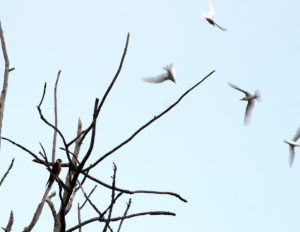
White Terns scolding a Peregrine Falcon in a tree, 2018, Midway Atoll. © Photo courtesy Martha Brown
Of the Manu-o-Ku offspring that are lost in bad weather or taken by predators, nature has equipped White Tern parents with exceptional replacement abilities. In a single breeding season, a Manu-o-Ku female can lay as many as 6 eggs. She lays only one egg, and a couple raise only one chick, at a time. A female that loses an egg, however, can lay another an average of 21 days later (range 10-to-57 days.)
Honolulu’s White Tern population now numbers around 3,000, the first in 1961 with one pair sitting on one egg near Kokohead Crater. These magnificent seabirds now raise chicks from Hawaii Kai to Pearl City.
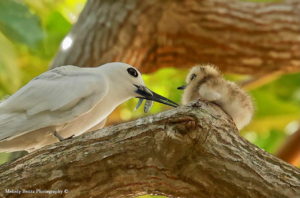
A parent feeds its chick at UH Manoa campus. ©Photo courtesy Melody Bentz
Our native heron and falcon are also magnificent species, both displaying remarkable survival skills in light of habitat loss, past pesticide poisonings, and former recreational shooting by the planet’s most relentless of predators, people.
You can show the kinder, gentler side of human nature by volunteering to help monitor and rescue our Manu-o-Ku. Go to https://www.whiteterns.org/ for information.
P.S. Several volunteers recently scheduled White Terns tours through the Hawaii Audubon Society but canceled due to high Covid-infection numbers. We’re hoping to reschedule for February and beyond. Check the Hawaii Audubon website’s Events/Field Trips for updates: https://www.hawaiiaudubon.org/get-outside